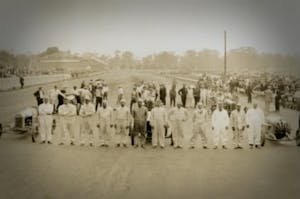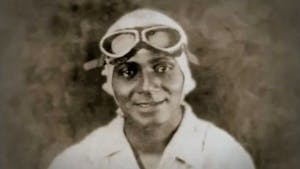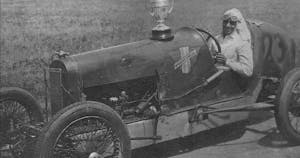Charlie Wiggins: The Jackie Robinson of American motorsports
You’ve undoubtedly heard of baseball great Jackie Robinson, who after being signed by Brooklyn Dodgers boss Branch Rickey broke Major League Baseball’s “color line” in 1947. Organized professional baseball had been racially segregated until then. Many of those who are now considered among the greatest to play the game never got a chance to put their skills to the ultimate test because they were Black. Instead, they perfected those skills in the Negro Leagues, which, in addition to providing opportunities for Blacks to play professional baseball, also provided entertainment opportunities to Blacks at a time when many American sports and entertainment venues were still segregated.
The same year that Robinson earned baseball’s first Rookie of the Year award, another color line was broken by Joseph “Joie” Ray, the first African-American to compete in a car race officially sanctioned by the American Automobile Association. Although Robinson went on to worldwide fame, Ray didn’t achieve quite the same level of celebrity, but he still had a long career racing midgets, sprint cars, and stock cars in the American Midwest from the 1940s into the ’60s, racing in events sanctioned by the AAA, IMCA, CSRA, and USAC.
The Gold and Glory

Before Joie Ray crossed motorsport’s color line, Black racers competed in their own racing series, as with baseball’s Negro Leagues, with African-American sanctioning bodies popping up throughout the Midwest in the 1920s and ’30s. The most successful of those was the Colored Speedway Association, based in Indianapolis. The CSA put on the Gold and Glory Sweepstakes, which became the largest Black-supported sporting event during that era, exceeding the attendance of even the best-attended Negro League games.
Denied the chance to compete at America’s premier racing event, the Indy 500, the racers of the Colored Speedway Association carved out their own place in racing history at dirt tracks in the American heartland. Their races drew thousands of spectators, and the series developed drivers of considerable talent, making them stars in the Black community. Perhaps the most talented among them was Charlie Wiggins, a gifted driver and mechanic who won the Gold and Glory race four times and became a valued mentor to generations of both Black and white drivers, including at least one eventual winner of the Indianapolis 500. When his protégé Bill Cummings wanted Wiggins to crew for him at the 1934 Indy race, race organizers would only allow Charlie in the facility as a janitor. Despite the indignity, by day Wiggins swept a broom in the paddock; by night he helped tune Cummings’ car. His car went on to win the race, while Wiggins watched Cummings drive to victory from the “colored” section of the segregated grandstands.
A history of bias in racing

Today we associate the name AAA with car insurance and travel services, but for decades the automobile club was the major sanctioning body for automobile racing in the United States. Until Joie Ray got his competition license in 1947, the AAA would not let Blacks compete in its events, despite the fact that a number of African-American drivers, mechanics, and car builders were highly regarded by their white peers. As a matter of fact, a number of white racers drove Wiggins’ cars, because he knew how to build fast ones. On one of those occasions, Indy 500 veteran Harry MacQuinn had entered one of Wiggins’ cars at a racetrack in Louisville, Kentucky. Before qualifying, when Wiggins took his car out on the track for his customary shakedown run—something he always did to make sure it was safe before turning it over to another driver—the sight of a Black driver on the track nearly caused the all-white crowd to riot. The state militia had to arrest Wiggins for his own safety. In the arrest report, the police captain listed “speeding” as the crime before releasing him.
The AAA’s discriminatory policy dated to at least 1910, when it refused to sanction a series of match races staged by famed racer Barney Oldfield and Jack Johnson, the first Black heavyweight world champion boxer. Oldfield and Johnson were both masters at self-promotion and expected to split considerable proceeds from the event. Despite the AAA’s disapproval, the races went on at the Sheepshead Bay horse track at Brooklyn’s Coney Island, with Oldfield taking two of three wins. Oldfield may have won that publicity event, but the AAA suspended him for life—ostensibly, for running in an unsanctioned race, but publicly racing against a Black man was likely a factor. When the AAA realized they had banned the most popular racer in America, the organization rescinded Oldfield’s suspension. Black drivers, however, were still not welcome.
The first Indianapolis 500 was held in 1911. By the Roaring ’20s there were speedways (usually dirt tracks with grandstands) from sea to shining sea and young men with dreams of speed and glory ready to race on those tracks. The 1920s were also a time when the long-dormant Ku Klux Klan revived, expanding geographically from the South. In particular, Indiana saw a dramatic increase in Klan activity, and the racist organization gained considerable political power in the state. Segregation in housing and entertainment increased. There was even a lynching with racial implications.
Despite the hostile environment, Black racers showed remarkable persistence. They would race however they could, for the glory and for the gold.
Charlie Wiggins finds his way

Charlie Wiggins was born in Evansville in southern Indiana in 1897, but for most of his childhood his family lived across the state line in Kentucky, where his father worked as a coal miner. Life was hard. Charlie’s mother died when he was nine years old and he would shine shoes to help feed his siblings. By the time of the 1910 census, though, the family had moved back to Evansville, where Charlie would find employment as a car mechanic during WWI. Wiggins, who was too young for the draft, had fallen in love with cars at an early age and decided to set up his shoe-shine stand near a local repair garage. As the military draft eventually took most of his mechanics, all of them white, the shop owner decided to ask Wiggins if he could turn a wrench. Soon recognizing the young man’s mechanical talent, the proprietor made Charlie a supervisor in the garage.
Charlie’s talents weren’t restricted to fixing cars and managing a business. He was personable and people liked him. At 17, he married a 22-year-old woman named Roberta, whom Charlie maintained was a more talented driver than some of the men he raced against. They were married for 65 years.
By 1921, Charlie and Roberta were living in Indianapolis. Jewish garage owner Louis Sagalowsky took Wiggins under his wing, and upon Sagalowsky’s retirement in 1924, he sold Charlie the repair facility on favorable terms. It was there that Wiggins’ dreams of racing finally took corporeal form in the shape of a race car fabricated at least partially from junkyard parts. He repeatedly tried to enter the car in the Indy 500 and other AAA sanctioned events, but the organization would not let him qualify.
Colored Speedway Association

That same year, 1924, successful Black entrepreneur William Rucker started the Colored Speedway Association in Indianapolis, joined by fellow African-Americans Harry Dunnington and attorney Robert Brokenburr. Two white businessmen, Harry Earl, a machine shop foreman and part-time race promoter, and Oscar Shilling, a mechanical engineer, put up the money.
The Colored Speedway Association’s first race was held at the Indiana State Fairgrounds in Indianapolis in August, with 10,000 people paying 50 cents each to watch. The 100-mile event was won by Malcolm Hannon, one of only three finishers, at an average speed of 64.5 mph. Jack Johnson presented the winner’s trophy.

Writing about the event for the Chicago Defender, one of the leading African-American newspapers of the day, journalist Frank Young said, “This auto race will be recognized throughout the length and breadth of the land as the single greatest sports event to be staged annually by colored people. Soon, chocolate jockeys will mount their gas-snorting, rubber-shod Speedway monsters as they race at death-defying speeds. The largest purses will be posted here, and the greatest array of driving talent will be in attendance in hopes of winning gold for themselves and glory for their Race.”
That last part stuck, and soon the annual race became known as The Gold and Glory Sweepstakes. Originally held on Emancipation Day, April 16, Rucker and the organizers moved the race to Independence Day, July 4, to give the race a patriotic air, mirroring the Indy 500’s Memorial Day scheduling. In time, the Gold and Glory race became the pinnacle of a barnstorming circuit that had Black drivers racing on tracks in Pennsylvania, Ohio, Kentucky, Michigan, Illinois, Wisconsin, and, of course, Indiana. The Gold and Glory Sweepstakes became a major national event for Black Americans, with every major African-American newspaper sending reporters to cover the race and associated festivities. The white-owned local Indianapolis newspaper, however, downplayed the event. Remember, it was a time when the KKK was ascendant in Indiana, with considerable political and economic power. Still, the Gold and Glory race was covered by national newsreel agencies.
Little man, big heart

Charlie Wiggins didn’t enter the first race in 1924. Apparently Rucker was concerned that, at just 5-foot-6 and weighing only 100 pounds, the slight Wiggins would not be able to control a race car.
In any case, his first attempt in 1925 didn’t turn out as well as he had hoped. He had speed to match the race leaders but a blown engine resulted in a DNF. Encouraged by his competitive speed, however, Wiggins decided to run a full schedule in 1926, a choice that proved to be wise. He won the 1926 Gold and Glory race by two laps and won eight of 10 Colored Speedway Association races that year, finishing in the top five in the other two. Though a diminutive man, Wiggins surprised many with his ability to control a powerful machine.
Wiggins placed second in the 1929 Gold and Glory and would go on to win three consecutive Gold and Glory races from 1931–33, earning him the unofficial title, “The Negro Speed King.” To get an idea of how competitive a driver Wiggins was, in the 1933 race, held at Harry Earl’s Walnut Garden Speedway not far from Indianapolis, he overcame a five-lap penalty for ignoring a yellow caution flag to win the race just ahead of his brother Lawrence, a talented driver in his own right.

The 1935 race was organized by a different group of promoters from Ohio, who absconded with the gate receipts before the race started. Attendees passed the hat to create a purse for the drivers, and a shortened race went on, but the scandal hurt the event.
The start of the following year’s race was delayed by a car owner’s protest over a competitor he accused of breaking the rules. The Indiana Fairgrounds’ dirt track had been watered to keep dust down, but the delay, which lasted two hours, caused the track to dry out. Both Charlie and Roberta had bad premonitions but Charlie told her, “You can’t ever be afraid. You have to face it. No, you can’t ever be afraid.”
The race began. Soon the dust made visibility poor and the ruts that were developing in the dry dirt made handling treacherous. A wreck occurred, sending one car airborne into the infield, and one after another a total of 13 cars were involved in the accident. Wiggins’ car was one of the first to wreck, overturning and pinning his leg under the car. Before he could be freed, another car hit his disabled racer, crushing his leg. Doctors had to amputate the limb; he also lost an eye. Wiggins’ racing career was over, and he would suffer from his injuries for the rest of his life.
Between the financial scandal of the previous year, the loss of its premier star, and the continuing Great Depression, the Colored Speedway Association faded away after the 1936 event.
Perseverance

While racing, Wiggins had continued to operate his Indianapolis garage, cementing his reputation as one of the racing capital’s best mechanics. That provided him with a means to support himself and Roberta after his accident, though they struggled financially.
Finances weren’t the Wiggins’ only troubles. The couple had lost three young children to tuberculosis and Roberta lost another to a miscarriage. Maybe that was the reason Charlie always welcomed kids to hang around his garage. White or Black, it didn’t matter to Wiggins; he welcomed them all. In time, the boys grew to be young men, known in the area as Charlie’s Gang. They’d come over every day after school or work and watch him work on customers’ cars and his own race cars. He’d mentor them about racing, things mechanical, and life.
Leon “Al” Warren competed with Wiggins in the Gold and Glory races, but before that he was part of Charlie’s Gang. “I got to going down by his garage, just going down and watching them working on the race cars and things,” Warren said in a 2002 PBS documentary, For Gold & Glory. “Charlie was swell. Everybody liked Charlie. He’d take time to explain things to everybody.”
Sumner “Red” Oliver was also part of Charlie’s Gang and in 1973 Wiggins was able to watch his protégé become the first African-American mechanic to officially be part of an Indy 500 team. Oliver wrenched for Pat Patrick’s highly respected race team, which won the Indianapolis race that year with Gordon Johncock at the wheel.
Another member of Charlie’s Gang was Bill Cummings, who first sat behind the wheel of a race car as a boy in Wiggens’ shop. Cummings respected Wiggins so much that he bent the Indianapolis Speedway’s racist rules to get Wiggins on his team.
Two men on different paths

Another rule bender of a different sort was also one of Charlie’s Gang—one of the white teenagers who hung out around Wiggins’ garage and known by the crew simply as Johnny. Johnny liked fast Fords and he and Charlie hit it off. They shared a passion for speed and Wiggins and Johnny would also hunt and fish together. Charlie would sometimes test his race cars on the deserted roads around Mooresville, Indiana, Johnny’s rural hometown, and invite Johnny to watch.
By the early 1930s, Johnny had stopped hanging around the shop and the two lost touch with one another. Then, one day in the summer of 1933, Charlie saw a familiar face on the front page of his morning newspaper under the headline, “Public Enemy Number One.” Johnny turned out to be John Dillinger, infamous for robbing banks—and for sending Henry Ford a fan letter praising the flathead V-8 Fords he used as getaway cars.
Wiggins died almost penniless in 1979. In a just world, the name Charlie Wiggins would be better known than that of John Dillinger. Undoubtedly he was a better role model. He loved motorsports so much that he wasn’t going to let the less-than-enlightened racial mores of the day keep him from his passion. He made a name for himself, leaving his mark on motorsport history, mentoring both an Indy 500 winning driver and a mechanic on a winning team, and positively influencing generations of racers.
Speaking of leaving his mark, in 2018, the Indiana Racing Memorial Association, dedicated to honor the memories of those who made the state the “Racing Capital of the World,” unveiled a historical marker for Charlie Wiggins that stands in front of Evansville’s African-American History Museum.

